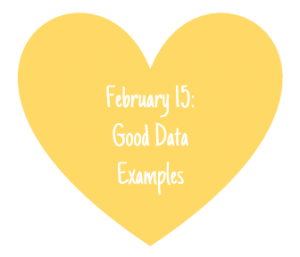Feb
15

Posted by Ann Madhavan on February 15th, 2017
Posted in: Data Science, News From NNLM PNR
 Welcome to day three of Love Your Data Week 2017! Today’s topic is Good Data Examples. What makes data “good” or “well managed?” The Fair Data Principles: Findability, Accessibility, Interoperability, and Reusability are a good place to start. Published by Mark Wilkinson and his colleagues in 2016, these principles “put specific emphasis on enhancing the ability of machines to automatically find and use the data, in addition to supporting its reuse by individuals.” 1A brief description of the principles, excerpted from Wilkinson’s article, explains:
Welcome to day three of Love Your Data Week 2017! Today’s topic is Good Data Examples. What makes data “good” or “well managed?” The Fair Data Principles: Findability, Accessibility, Interoperability, and Reusability are a good place to start. Published by Mark Wilkinson and his colleagues in 2016, these principles “put specific emphasis on enhancing the ability of machines to automatically find and use the data, in addition to supporting its reuse by individuals.” 1A brief description of the principles, excerpted from Wilkinson’s article, explains:
To be Findable:
To be Accessible:
To be Interoperable:
To be Reusable:
These guiding principles benefit all stakeholders, including, as Wilkinson states, “researchers wanting to share, get credit, and reuse each other’s data and interpretations; professional data publishers offering their services; software and tool-builders providing data analysis and processing services such as reusable workflows; funding agencies (private and public) increasingly concerned with long-term data stewardship; and a data science community mining, integrating and analyzing new and existing data to advance discovery.”3
Wilkinson identifies several examples of FAIRness, including Dataverse, FAIRDOM, and Open PHACTS, and notes that the FAIR Guiding Principles have been adopted by a wide range of data management organizations across the globe.
1-3Wilkinson MD, Dumontier M, Aalbersberg IJ, Appleton G, Axton M, Baak A, Blomberg N, Boiten JW, da Silva Santos LB, Bourne PE, et al. The FAIR Guiding Principles for scientific data management and stewardship. Sci Data. 2016 Mar 15;3:160018. doi: 10.1038/sdata.2016.18. PubMed PMID: 26978244; PubMed Central PMCID: PMC4792175.